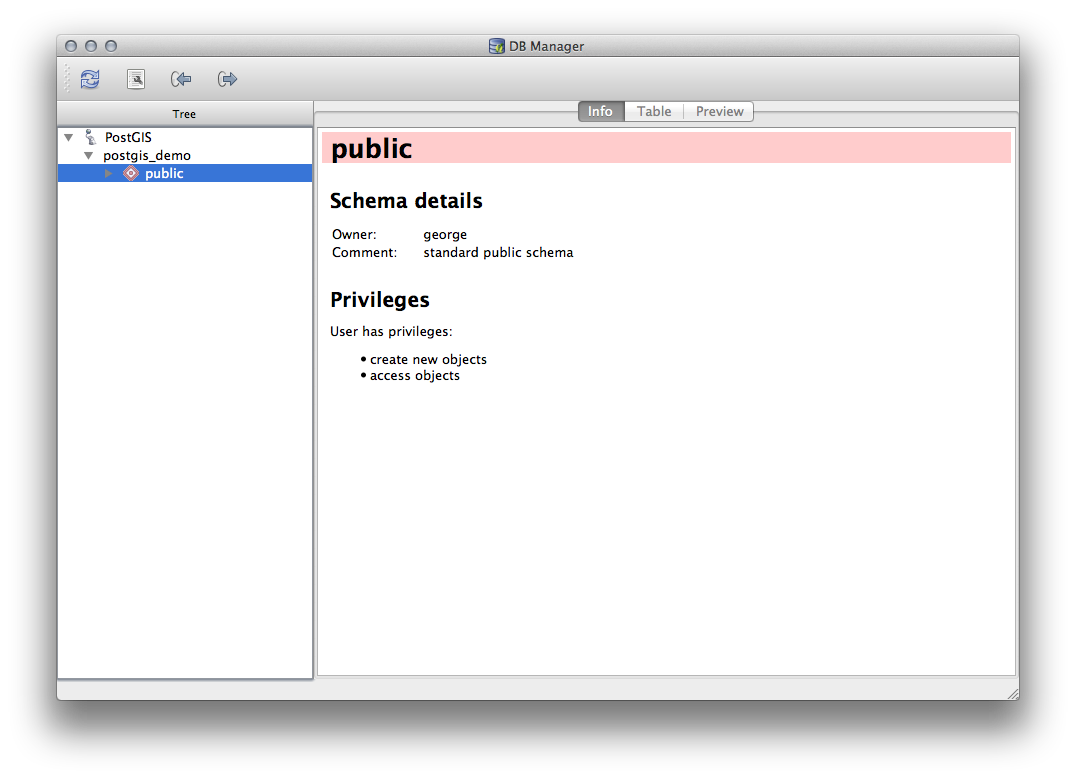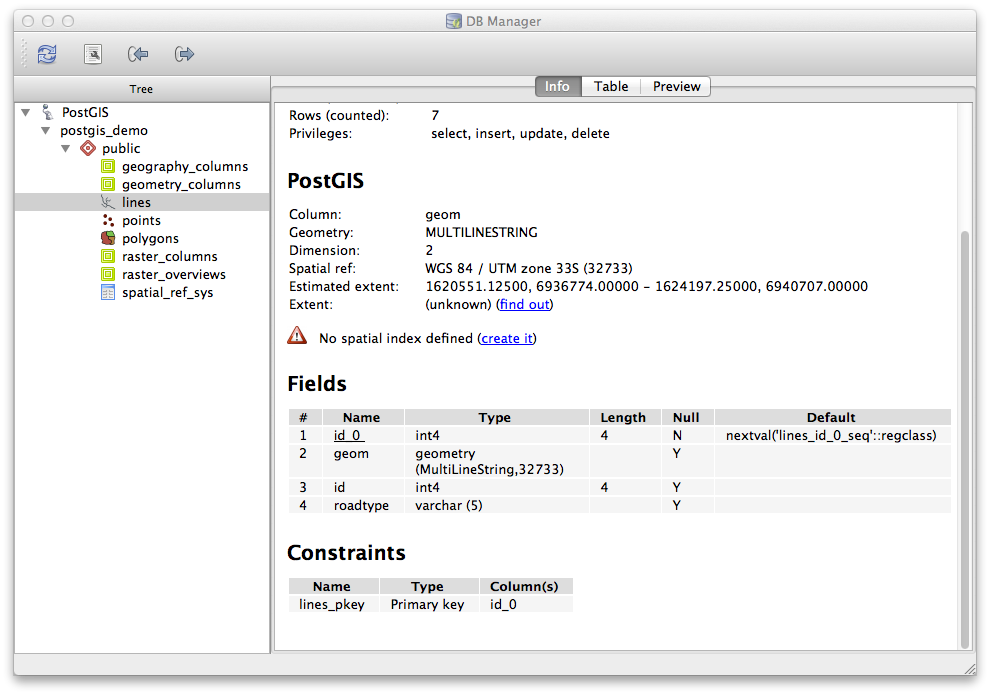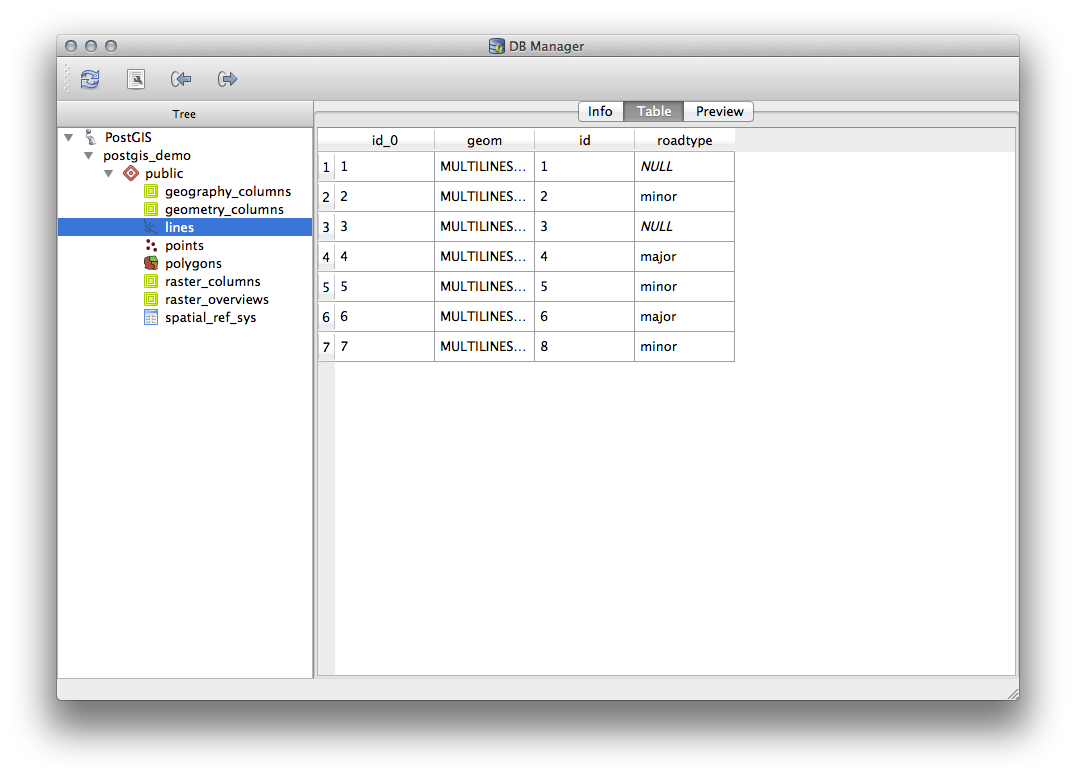18.2. Lesson: Utilizarea DB Manager din QGIS, în lucrul cu bazele de date spațiale¶
We have already seen how to perform many database operations with QGIS as well as with other tools, but now it’s time to look at the DB Manager tool which provides much of this same functionality as well as more management oriented tools.
Scopul acestei lecții: De a se învăța interacțiunea cu bazele de date raster, folosind interfața DB Manager din QGIS.
18.2.1.  Follow Along: Gestionarea Bazelor de date PostGIS cu ajutorul DB Manager¶
Follow Along: Gestionarea Bazelor de date PostGIS cu ajutorul DB Manager¶
You should first open the DB Manager interface by selecting Database –> DB Manager –> DB Manager on the menu or by selecting the DB Manager icon on the toolbar.
You should already see the previous connections we have configured and be able
to expand the myPG section and its public schema to see the
tables we have worked with in previous sections.
The first thing you may notice is that you can now see some metadata about the Schemas contained in your database.

Schemas are a way of grouping data tables and other objects in a PostgreSQL database and a container for permissions and other constraints. Managing PostgreSQL schemas is beyond the scope of this manual, but you can find more information about them in the PostgreSQL documentation on Schemas. You can use the DB Manager to create new Schemas, but will need to use a tool like pgAdmin III or the command line interface to manage them effectively.
DB Manager can also be used to manage the tables within your database. We have already looked at various ways to create and manage tables on the command line, but now lets look at how to do this in DB Manager.
First, its useful to just look at a table’s metadata by clicking on its name in tree and looking in the Info tab.

In this panel you can see the General Info about the table as well the information that the PostGIS extension maintains about the geometry and spatial reference system.
If you scroll down in the Info tab, you can see more information about the Fields, Constraints and Indexes for the table you are viewing.

Its also very useful to use DB Manager to simply look at the records in the database in much the same way you might do this by viewing the attribute table of a layer in the Layer Tree. You can browse the data by selecting the Table tab.

Există, de asemenea o filă Preview, care vă va arăta datele stratului într-o hartă de previzualizare.
Click-dreapta pe unul dintre straturi și, făcând clic pe Add to Canvas, acesta se va adăuga pe hartă.
So far we have only been viewing the database its schemas and tables and their metadata, but what if we wanted to alter the table to add an additional column perhaps? DB Manager allows you to do this directly.
Selectați din arbore tabela pe care doriți să o editați
Selectați meniul Table –> Edit Table`pentru a deschide dialogul :guilabel:`Tabelei de Proprietăți.

Puteți folosi acest dialog pentru a Adăuga Coloane, Coloane pentru geometrii, pentru a edita coloanele existente sau pentru a elimina complet o coloană.
Using the Constraints tab, you can manage which fields are used as the primary key or to drop existing constraints.

Fila Indecșilor poate fi folosită pentru a adăuga și șterge atât indicii spațiali, cât și cei normali.

18.2.2.  Follow Along: Crearea unei Noi Tabele¶
Follow Along: Crearea unei Noi Tabele¶
Acum, că am trecut prin procesul de lucru cu tabelele existente în baza noastră de date, haideți să folosim DB Manager pentru a crea o nouă tabelă.
În cazul în care nu este deschisă deja, deschideți fereastra DB Manager, și apoi extindeți arborele până când se vede lista tabelelor prezente deja în baza dvs. de date.
Selectați meniul :guilabel:`Table –> Create Table`pentru a deschide dialogul de Creare a Tabelei.
Folosiți schema
Public, implicită, și denumiți tabelaplaces.Adugați câmpurile
id,place_nameșielevation, așa cum se arată mai josAsigurați-vă că ați setat câmpul
idca și cheie primară.- Click the checkbox to Create geometry column and make sure it is
set to a
POINTtype and leave it namedgeomand specify4326as the SRID. - Click the checkbox to Create spatial index and click Create to create the table.

- Dismiss the dialog letting you know that the table was created and click Close to close the Create Table Dialog.
You can now inspect your table in the DB Manager and you will of course find that there is no data in it. From here you can Toggle Editing on the layer menu and begin to add places to your table.
18.2.3.  Follow Along: Tehnici de bază pentru administrarea bazei de date¶
Follow Along: Tehnici de bază pentru administrarea bazei de date¶
The DB Manager will also let you do some basic Database Administration tasks. It is certainly not a substitute for a more complete Database Administration tool, but it does provide some functionality that you can use to maintain your database.
Database tables can often become quite large and tables which are being modified frequently can end up leaving around remnants of records that are no longer needed by PostgreSQL. The VACUUM command takes care of doing a kind of garbage collection to compact and optional analyze your tables for better performance.
Să aruncăm o privire la modul în care putem efectua o comandă VACUUM ANALYZE din cadrul DB Manager.
Selectați una dintre tabelele din Arborele DB Manager.
Selectați Table –> Run Vacuum Analyze din meniu.
Asta e! PostgreSQL va efectua operațiunea. În funcție de cât de mare este tabela dvs., poate dura ceva timp până la încheiere.
Puteți găsi mai multe informații despre procesul de ANALIZĂ VACUUM din Documentația PostgreSQL referitoare la ANALIZA VACUUM
18.2.4.  Follow Along: Executarea Interogărilor SQL cu ajutorul DB Manager¶
Follow Along: Executarea Interogărilor SQL cu ajutorul DB Manager¶
DB Manager also provides a way for you to write queries against your database tables and to view the results. We have already seen this type of functionality in the Browser panel, but lets look at it again here with DB Manager.
Selectați din arbore tabela
linii.Selectați butonul SQL window din bara de instrumente DB Manager.

Compuneți următoarea Interogare SQL în spațiul furnizat:
select * from lines where roadtype = 'major';
Clic pe butonul Execute (F5) pentru a rula interogarea.
Ar trebui să vedeți acum înregistrările care corespund panoului Rezultate.

Faceți clic pe caseta de bifare Load as new layer pentru a adăuga rezultatele în harta dvs.
- Select the
idcolumn as the Column with unique integer values and thegeomcolumn as the Geometry column. Introduceți
roads_primaryca și Nume pentru strat (prefix).Faceți clic pe Load now! pentru a încărca rezultatele ca un nou strat în harta dvs.

The layers that matched your query are now displayed on your map. You can of course use this query tool to execute any arbitrary SQL command including many of the ones we looked at in previous modules and sections.
18.2.5. Importarea datelor dintr-o Bază de date cu ajutorul DB Manager¶
We have already looked at how to import data into a spatial database using command line tools and also looked at how to use the SPIT plugin, so now lets learn how to use DB Manager to do imports.
Clic pe butonul Import layer/file din Bara de Instrumente a dialogului DB Manager.

Selectați fișierul
urban_33S.shpdinexercise_data/projected_dataca și set de date de intrare.Clic pe butonul Opțiunilor de actualizare pentru a pre-completa unele din valorile formularului.
Asigurați-vă că este selectată opțiunea Creare tabelă nouă.
Specificați
32722pentru SRID-ul Sursă și4326pentru SRID-ul Destinație.Activați caseta de bifare pentru a Crea îndexul Spațial
Clic pe OK, pentru a se efectua importul.

Închideți dialogul care vă informează că importul a avut loc cu succes
Clic pe butonul Refresh din Bara de Instrumente DB Manager.
You can now inspect the table in your database by clicking on it in the Tree.
Verify that the data has been reprojected by checking that the
Spatial ref: is listed as WGS 84 (4326)

Right clicking on the table in the Tree and a selecting Add to Canvas will add the table as a layer in your map.
18.2.6. Exportul datelor cu DB Manager dintr-o Bază de date¶
De asemenea, DB Manager se poate utiliza pentru exportul datelor din bazele de date spațiale, așa că haideți să aruncăm o privire la modul în care se face aceasta.
- Select the
lineslayer in the Tree and click the Export to File button on the toolbar to open the Export to vector file dialog. - Click the ... button to select the Output file and
save the data to your
exercise_datadirectory asurban_4326. Introduceți
4326în Target SRID.Clic OK pentru a inițializa exportul.

Închideți dialogul care vă informează că exportul a avut loc cu succes, apoi închideți DB Manager.
Puteți inspecta de acum fișierul shape pe care l-ați creat cu panoul de Răsfoire.

18.2.7. In Conclusion¶
Ați aflat cum să folosiți de acum interfața DB Manager din QGIS, pentru a gestiona bazele de date spațiale, pentru a executa interogări SQL asupra datelor dvs. și cum să importați și să exportați datele.
18.2.8. What’s Next?¶
Next, we will look at how to use many of these same techniques with spatialite databases.
